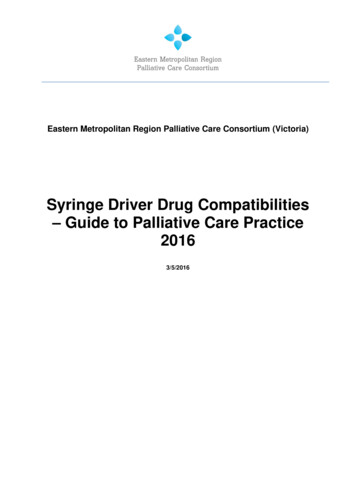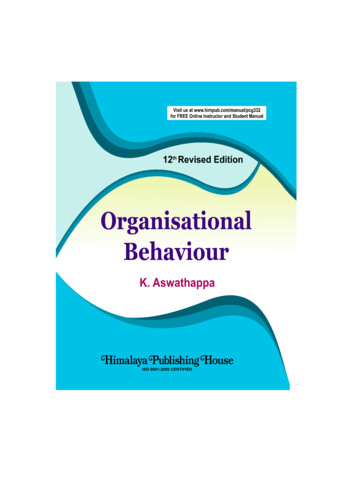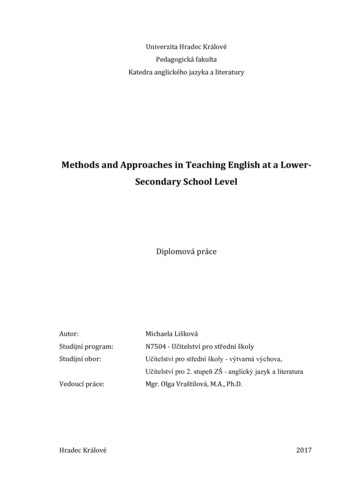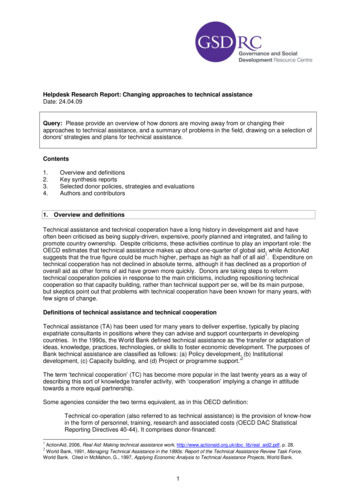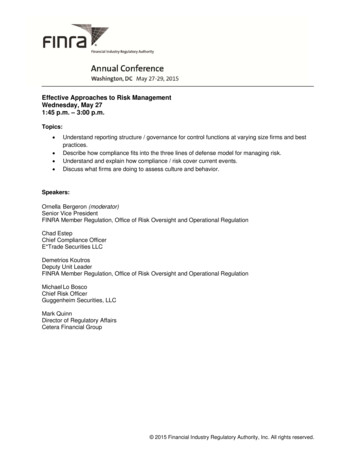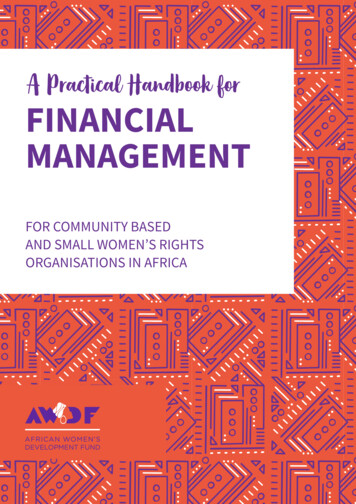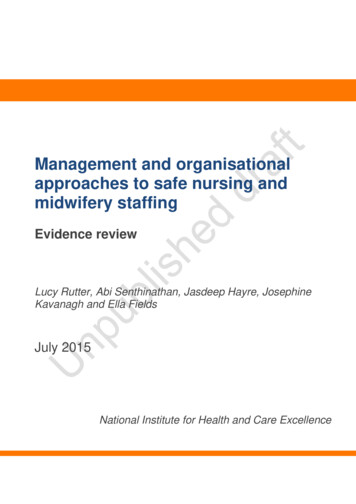
Transcription
Management and organisationalapproaches to safe nursing andmidwifery staffingEvidence reviewLucy Rutter, Abi Senthinathan, Jasdeep Hayre, JosephineKavanagh and Ella FieldsJuly 2015National Institute for Health and Care Excellence
AcknowledgementsThanks to Tom Hudson, Paul Levay, Rachel Adams and Jenny Kendrick for developing searchstrategies and undertaking the literature searches. Thanks also to those stakeholders who identifiedadditional material for us to consider within the review.Copyright National Institute for Health and Care Excellence 2015. All rights reserved. This material may befreely reproduced for educational and not-for-profit purposes within the NHS. No reproduction by orfor commercial organisations is allowed without the express written permission of the NationalInstitute for Health and Care Excellence.
Management and organisational approaches to safe nursing and midwifery staffingContentsExecutive Summary . 51 Overview . 71.1 Introduction . 71.2 Review Questions . 82 Methods . 102.1 Overview . 102.2 Search Strategy . 112.2.1 Review of reviews search . 112.2.2 ‘Gap’ Search . 122.2.3 ‘Top up’ Searches . 122.3 Screening Criteria . 132.3.1 Operational definitions . 142.3.2 Outcomes . 152.4 Search Results . 162.4.1 Review of Reviews . 162.4.2 ‘Gap’ Search . 162.4.3 ‘Top up’ Searches . 162.5 Critical Appraisal and Quality Assessment – Review of Reviews. 192.5.1 R-AMSTAR checklist for systematic reviews . 192.6 Data Extraction and Evidence Tables – Review of Reviews . 202.7 Evidence Synthesis – Review of Reviews . 203 Results – Review of Reviews . 213.1 Review Question 1 . 213.1.1 Review Question . 223.1.2 Evidence . 223.1.3 Evidence Statements . 373.2 Review Question 2 . 393.2.1 Review Question . 393.2.2 Evidence . 393.2.3 Evidence Statements . 393.3 Review Question 3 . 403.3.1 Review Question . 403.3.2 Evidence . 403.3.3 Evidence Statements . 453.4 Review Question 4 . 463.4.1 Review Question . 463.4.2 Evidence . 464.4.3 Evidence Statements . 643.5 Review Question 5 . 663.5.1 Review Question . 663.5.2 Evidence . 663.5.3 Evidence Statements . 744 Conclusions. 774.1. Summary of the evidence . 774.2. Gaps in the evidence . 774.3. Suggested research areas . 785 References . 805.1 Bibliography . 80 National Institute for Health and Care Excellence 2015
Management and organisational approaches to safe nursing and midwifery staffing5.2Included Reviews . 80 National Institute for Health and Care Excellence 2015
Management and organisational approaches to safe nursing and midwifery staffingExecutive SummaryExecutive SummaryIn 2013 the Department of Health and NHS England asked the National Institute for Healthand Care Excellence (NICE) to develop evidence based guidelines on safe staffing with aparticular focus on nursing staff for England.NICE began work on the fifth topic it was referred - management and organisationalapproaches that support safe staffing in 2015. This report presents the findings fromsystematic review of the available evidence. In June 2015 the Safe Staffing guidelineprogramme was suspended.The review presented in this report aims to systematically identify, assess and synthesisethe available evidence relating to the following questions: What staff and team management approaches are effective for supporting safe staffingacross an organisation and how should they be implemented? For example:oWhat methods for assessing or changing management approaches are effective andhow reliable and valid are they?oHow often should the approaches be used?oHow do these approaches influence the delivery of safe nursing and midwifery care?What management systems are effective for supporting safe staffing across anorganisation and how should they be implemented? For example:oWhat methods for assessing or changing management systems are effective andhow reliable and valid are they?oHow often should the approaches be used?oHow do these approaches influence the delivery of safe nursing and midwifery care?What approaches for addressing risk to patient care posed by variation in demand forservices, variation in patient or service user needs, or deficits in nursing and midwiferystaff levels and skill mix across an organisation are effective? How should they beimplemented? For example:oWhat methods for assessing or changing approaches for addressing risk to patientcare posed by variation in demand for services, variation in patient or service userneeds, or deficits in nursing and midwifery staff levels and skill mix are effective andhow reliable and valid are they?oHow often should the approaches be used?oHow do these approaches influence the delivery of safe nursing and midwifery care?What organisational approaches are effective for assessing and changingorganisational culture and support safe staffing for nursing and midwifery across anorganisation? How should these approaches be implemented? For example:oWhat methods for assessing or changing organisational culture are effective andhow reliable and valid are they?oHow often should the approaches be used? National Institute for Health and Care Excellence 2015Page 5 of 81
Management and organisational approaches to safe nursing and midwifery staffingExecutive Summaryo How do these approaches influence the delivery of safe nursing and midwifery care?What organisational approaches are effective for assessing and changingorganisational leadership and support safe staffing for nursing and midwifery across anorganisation? How should these approaches be implemented? For example:oWhat methods for assessing or changing organisational leadership are effective andhow reliable and valid are they?oHow often should the approaches be used?oHow do these approaches influence the delivery of safe nursing and midwifery care?The evidence review presented in this report consists of 3 main elements. The first elementis a ‘review of reviews’ that presents a high level overview of the evidence available fromother published systematic reviews. The second element is a search for relevant primaryresearch to address review questions where no review-level evidence was found (‘gap’searches). The third element is a search for relevant primary research that has beenpublished since the relevant systematic reviews were published (‘top up’ searches).For the review of reviews, fifteen systematic reviews were identified for inclusion in thisreport. This included 3 ‘empty’ systematic reviews that did not identify any studies forinclusion. Five of the 15 systematic reviews addressed staff and team managementapproaches to safe staffing while another 5 addressed approaches for assessing andchanging organisational culture. Three systematic reviews focused on approaches toaddressing deficits in nursing and midwifery staff levels and 2 investigated approaches tochanging organisational leadership. No systematic reviews of relevant economic evaluationsor analyses were identified to address any of the review questions.The 15 systematic reviews included in this report assessed the effectiveness of a widevariety of management and organisational approaches. The interventions identified withinthe included reviews were highly heterogeneous and many were complex interventionscomprising numerous diverse elements. Findings were generally mixed and overall therewas a lack of high quality systematic review-level evidence to support robust conclusionsabout the effectiveness of management and organisational approaches to support safestaffing for nurses and midwives.The ‘top up’ searches returned 33,243 references for screening. The results of thesesearches are available on request to anyone who may be undertaking research on this topicin the future.No systematic reviews were identified to assess the effectiveness of management systemsto support safe staffing. Therefore a ‘gap’ search was performed to identify relevant primarystudies. A reference list of 313 provisionally identified papers from this search is provided inthe appendices of this report. National Institute for Health and Care Excellence 2015Page 6 of 81
Management and organisational approaches to safe nursing and midwifery staffingOverview1 OverviewThe National Institute for Health and Care Excellence (NICE) was asked by the Departmentof Health and NHS England to develop an evidence based guideline on management andorganisational approaches to support safe staffing for nursing and midwifery. NICE beganwork on this topic in February 2015 and a scope was developed which outlined the 5 reviewquestions to be addressed by this evidence review.This report presents the systematic review findings which were going to inform thedevelopment of this topic area. In June 2015 the Safe Staffing guideline programme wassuspended.1.1IntroductionRecent reports and policy documents highlight the importance of effective organisational andmanagement strategies, policies and interventions in ensuring the delivery of safe, highquality care across health and social care services. For example, NHS services should havean open and transparent organisational culture that enables safe, high-quality andcompassionate care to be continually provided and improved in line with the followingprinciples outlined in the Francis report: commitment to common values throughout the organisation by all involved fundamental standards that are readily accessible and can be complied with rigorous policing of compliance with the fundamental standards and zero tolerance of alack of compliance openness, transparency and candour throughout the organisation strong leadership in nursing and midwifery strong support for leadership roles accountability of everyone within the organisation information on performance accessible and useable by all, allowing effectivecomparison by individuals, services and organisation.Leadership has been identified as the most influential factor in shaping organisational culture(King's Fund 2014). The 2014 King's Fund survey on culture and leadership in the NHSrevealed that staff views of leadership in the NHS have improved over time, but most staffstill believe that leadership is poor or very poor. The survey also revealed a difference instaff views about their organisational culture – board executives were more positive aboutthe organisational culture than other staff, particularly nurses. Importantly, only 40% ofresponders agreed that concerns would be dealt with properly. Therefore, there is still a longway to go towards achieving services with organisational cultures that nurture safe, highquality and compassionate care. The King’s Fund has been commissioned to reviewleadership and management in NHS services: The King's Fund (2015) Leadership and leadership development in health care: theevidence base National Institute for Health and Care Excellence 2015Page 7 of 81
Management and organisational approaches to safe nursing and midwifery staffingOverview The King's Fund (2014) Developing collective leadership for healthcare The King's Fund (2013) Patient-centred leadership: rediscovering our purpose The King's Fund (2012) Leadership and engagement for improvement in the NHS:together we can The King's Fund (2011) The future of leadership and management in the NHS: no moreheroesOther general policy documents that highlight the need for guidelines on management andorganisational approaches to safe staffing include: Department of Health (2015) Culture change in the NHS: applying the lessons of theFrancis Inquiries National Quality Board (2013) How to ensure the right people, with the right skills, are inthe right place at the right time: a guide to nursing, midwifery and care staffing capacityand capability Department of Health (2013) Hard truths: the journey to putting patients first Department of Health (2011) NHS staff management and health service qualityThe evidence review presented in this report is intended to identify the evidence base whichwould help determine the effectiveness of management and organisational approaches tosupport safe staffing across all settings in which NHS nursing and midwifery care isdelivered.1.2Review QuestionsFive review questions were identified and developed during the scoping of this topic:1. What staff and team management approaches are effective for supporting safe staffingacross an organisation and how should they be implemented?o What methods for assessing or changing management approaches are effective andhow reliable and valid are they?o How often should the approaches be used?o How do these approaches influence the delivery of safe nursing and midwifery care?2. What management systems are effective for supporting safe staffing across anorganisation and how should they be implemented?o What methods for assessing or changing management systems are effective andhow reliable and valid are they?o How often should the approaches be used?o How do these approaches influence the delivery of safe nursing and midwifery care?3. What approaches for addressing risk to patient care posed by variation in demand forservices, variation in patient or service user needs, or deficits in nursing and midwiferystaff levels and skill mix across an organisation are effective? How should they beimplemented? National Institute for Health and Care Excellence 2015Page 8 of 81
Management and organisational approaches to safe nursing and midwifery staffingOverviewoooWhat methods for assessing or changing approaches for addressing risk to patientcare posed by variation in demand for services, variation in patient or service userneeds, or deficits in nursing and midwifery staff levels and skill mix are effective andhow reliable and valid are they?How often should the approaches be used?How do these approaches influence the delivery of safe nursing and midwifery care?4. What organisational approaches are effective for assessing and changing organisationalculture and support safe staffing for nursing and midwifery across an organisation? Howshould these approaches be implemented?o What methods for assessing or changing organisational culture are effective andhow reliable and valid are they?o How often should the approaches be used?o How do these approaches influence the delivery of safe nursing and midwifery care?5. What organisational approaches are effective for assessing and changing organisationalleadership and support safe staffing for nursing and midwifery across an organisation?How should these approaches be implemented?o What methods for assessing or changing organisational leadership are effective andhow reliable and valid are they?o How often should the approaches be used?o How do these approaches influence the delivery of safe nursing and midwifery care? National Institute for Health and Care Excellence 2015Page 9 of 81
Management and organisational approaches to safe nursing and midwifery staffingMethods2 Methods2.1OverviewGiven the breadth of the review topic, a decision was taken to approach the evidence reviewpresented in this report in 3 stages: A ‘review of reviews’ through a review of secondary evidence from published systematicreviews. Searches for primary studies when no review-level evidence was found to address aparticular review question (‘Gaps’ search). ‘Top-up’ searches for additional primary studies published after the last search date ofany identified reviews.This systematic ‘review of reviews’ was conducted in accordance with Developing NICEGuidelines: the manual (NICE 2014) and Methods for the development of NICE public healthguidance (third edition) (NICE 2012).The evidence review included the following steps: For the review of reviews:oDatabases were searched using a peer-reviewed search strategy (Appendix A).oPotentially relevant systematic reviews, including reviews of economic evaluations,were identified by reviewing titles and abstracts using the pre-specified inclusion andexclusion criteria described in the review protocols (Appendix B). A second reviewerperformed a consistency check by screening the titles and abstracts of a randomsample of 10% of the references against the same checklist. Inter-rater agreementbetween the 2 reviewers was 100%.oThe full text of all references assessed to be potentially relevant were retrieved andindependently screened against the pre-specified inclusion and exclusion criteria(Appendix B) by two reviewers. Any disagreements between the 2 reviewers werediscussed and resolved with recourse to a third reviewer when necessary.oIncluded systematic reviews were quality appraised using the R-AMSTAR tool. Asecond reviewer performed a consistency check by critically appraising a randomsample of 30% of the included reviews.oRelevant data from included systematic reviews were extracted into evidence tables(Appendix C). Each evidence table was independently checked by 2 other reviewers.oThe evidence from primary studies included within the systematic reviews was alsosummarised into results tables and a narrative description of the findings wasproduced.oEvidence statements were generated.For the ‘gap’ searches:oDatabases were search using a peer-reviewed search strategy (Appendix A). National Institute for Health and Care Excellence 2015Page 10 of 81
Management and organisational approaches to safe nursing and midwifery staffingMethods oPotentially relevant primary studies, including economic evaluations, were identifiedby reviewing titles and abstracts using the pre-specified inclusion and exclusioncriteria described in the review protocols (Appendix B).oA reference list of the provisionally identified full text papers was produced(Appendix D), as this may prove useful for others who may be undertaking researchon this topic in the future.For the ‘top up’ searches:oDatabases were search using a peer-reviewed search strategy (Appendix A). Thesearch results for each top up search are available on request.2.2Search Strategy2.2.1Review of reviews searchA search strategy and review protocol were developed to identify relevant systematicreviews including reviews of economic evaluations (see Appendices A and B). The searchstrategy was developed by an information specialist and was quality assured by a colleaguewithin NICE’s Information Services team.The search strategy included the following databases: Cochrane Database of Systematic Reviews (CDSR) Cochrane Effective Practice and Organisation of Care (EPOC) group reviews Cumulative Index to Nursing and Allied Health Literature (CINAHL) Database of Abstracts of Reviews of Effects (DARE) EconLit Embase Health Business Elite Health Management Information Consortium (HMIC) Health Technology Assessment Database (HTA) Medline Medline-In-Process NHS Economic Evaluation Database (NHS EED)To identify other potentially relevant evidence, the following resources and approaches werealso used: Google Scholar and NICE Evidence were searched for grey literature. Potentially relevant references provided by stakeholders during scope consultation wereconsidered, as were any additional studies identified by NICE. National Institute for Health and Care Excellence 2015Page 11 of 81
Management and organisational approaches to safe nursing and midwifery staffingMethods Backwards and forwards citation searching on included reviews and other relevantpapers was undertaken as required.Following the advice from a topic expert, a date restriction of 1998 was imposed on thesystematic review and primary studies published before this date, or which used datacollected before this date, were excluded. This is because practice and standards withinhealthcare organisations have changed substantially since the late 1990s.2.2.2‘Gap’ SearchNo systematic reviews were identified to address review question 2. To address this, aseparate search was undertaken to identify relevant primary studies. This search strategywas designed and peer-reviewed by NICE information specialists; full details are available inAppendix A.The search strategy included the following databases: Cochrane Central Register of Controlled Trials (CENTRAL) Cochrane Database of Systematic Reviews Cumulative Index to Nursing and Allied Health Literature (CINAHL) Database of Abstracts of Reviews of Effect (DARE) Embase EconLit Health Business Elite Health Management Information Consortium (HMIC) Medline Medline-In-ProcessFollowing the advice from a topic expert, a date restriction of 1998 was imposed on theprimary studies, and studies published before this date, or which used data collected beforethis date, were excluded. This is because practice and standards within healthcareorganisations have changed substantially since the late 1990s.2.2.3‘Top up’ SearchesWhile 15 systematic reviews were identified to address review questions 1, 3, 4 and 5, thesystematic reviews were published between 1 month and 8 years ago and many onlypartially addressed the review questions. To address this, ‘top up’ searches were planned toidentify any relevant primary studies that were not published at the time the varioussystematic reviews were published.The search strategies for these top up searches were designed and peer-reviewed by NICEinformation specialists. Three search strategies were designed for this search: 1 each forreview questions 1 and 3, and a combined search strategy for review questions 4 and 5. All National Institute for Health and Care Excellence 2015Page 12 of 81
Management and organisational approaches to safe nursing and midwifery staffingMethodsof the search strategies were run at the same time; full details are available in Appendix A.The combined search results for review questions 4 and 5 were separated in Endnote tocreate separate lists of search results for each question. The list of search results for reviewquestion 5 includes all of the studies from the combined search. The list of search results forreview question 4 is identical to review question 5 except that all of the references for paperspublished before 2008 were removed from the search results, as the last search date of theincluded systematic reviews for review question 4 was 2009.The search strategies included the following databases: Cochrane Central Register of Controlled Trials (CENTRAL) Cumulative Index to Nursing and Allied Health Literature (CINAHL) EconLit Embase Health Business Elite Health Management Information Consortium (HMIC) Health Technology Assessment Database (HTA) Medline Medline-In-Process NHS Economic Evaluation Database (NHS EED).2.3Screening CriteriaReview of ReviewsFull text papers were requested for all references identified through the search strategy thathad titles and abstracts which looked relevant to any of the review questions.All full text papers for the ‘review of reviews’ underwent a 2 stage screening process.The full text papers had to meet the following 3 broad criteria in order to be classified as asystematic review: conduct a search of at least 2 electronic databases screen identified studies against an a priori research question or pre-specified inclusioncriteria assess the scientific quality of all included studiesTo maximise the applicability of identified evidence to current UK health and social caresettings, criteria were applied to restrict inclusion to reviews which included a high proportionof relevant evidence. For a systematic review to be eligible for inclusion in this ‘review ofreviews’ at least 80% of its included studies had to meet all of the following criteria: conducted in an OECD country and National Institute for Health and Care Excellence 2015Page 13 of 81
Management and organisational approaches to safe nursing and midwifery staffingMethods conducted no earlier than 1998 and primary research articles (i.e. not a case study, opinion piece or editorial etc.).This 80% relevance threshold is recommended in Methods for the development of NICEpublic health guidance (third edition) (NICE 2012).All systematic reviews which met the criteria listed above were then assessed against theinclusion and exclusion criteria set out in the review protocol (Appendix B). Systematicreviews had to consider the effectiveness of organisational and management approacheswhich may support safe staffing for nurses and midwives. Systematic reviews examining theeffectiveness of different models of care or service delivery were not within the scope of thisreview and were discarded. Systematic reviews which assessed organisational andmanagement approaches without clear links to nursing or midwifery staff were alsoexcluded. Examples of management and organisational approaches are provided undereach review question. A full list of the inclusion and exclusion criteria for this evidence reviewcan be found in the review protocol in Appendix B.‘Gap’ SearchThe results of the ‘gap’ search were screened based on title and abstract. References withabstracts that met the inclusion criteria (or did not meet the exclusion criteria) outlined in thereview protocol (Appendix B) are included in the reference list in Appendix D.‘Top up’ SearchesThe results of the ‘top up’ searches were not screened. The total number of search results isreported in section 2.4.3.2.3.1Operational definitionsNursing and midwifery staffing: the group of workers delivering ‘hands on’ nursing ormidwifery care in an NHS setting including: registered nurses registered midwives non-registered nursing and midwifery staff such as healthcare assistants, maternitysupport workers and assistant practitioners.Organisational or management approach: This is a broad term intended to encompassany policy, strategy or intervention implemented at an organisational level; that is, anyapproach which applies across an organisation. The unit of organisation may vary, forexample, an entire NHS Trust or a single residential care home. The term excludesapproaches only implemented in specific settings within a wider organisation (for example,one department or ward within a hospital) as well as those policies which are enacted at amore
o What methods for assessing or changing organisational leadership are effective and how reliable and valid are they? . strong leadership in nursing and midwifery . (2011) The future of lead

